The Evolution of the Pentax M42 Mount
History, Variations, and Techniques for Pentax Digital
By stevebrot in Articles and Tips on Mar 20, 2019
 The original Asahi Pentax (informally called the "AP")
The original Asahi Pentax (informally called the "AP")
With the introduction in 1957 of their first SLR with a pentaprism dubbed the Asahi Pentax (colloquially known as the "AP"), Asahi Optical Co. opted for the M42 screw mount which we shall take a closer look at in this article.
Evolution and Significance
Since the 1936 debut of the Ihagee Kine Exakta, the first 35mm SLR interchangeable lens camera, there have been a multitude of SLR camera models sporting a large variety of different mount designs. While all satisfied the basic task of mating to compatible lenses, most are no longer being used and only a very few have been used for more that 30 years with only three (M42, Nikon F, and Pentax K) surviving to the present day. Of those three, the M42 screw mount has been in use the longest and is of particular interest to Pentax camera owners in that it is one of three mounts historically used by Pentax SLR cameras and continues to be popular, in adapted form, with Pentax owners today.
One of the unique characteristics of the M42 mount has been its broad acceptance by many makers of lenses and cameras as a simple and practically universal basis for attachment of lens to camera. That acceptance has been based on the relative simplicity of the mount as well as non-proprietary character of its common forms. Dozens of makers have produced M42 mount cameras with Praktica and Pentax being the most prominent associated names. An even larger number of lens and accessory makers have supported the mount over the years such that there remains an impressive catalog of surviving vintage lenses and accessories compatible with current and legacy Pentax bodies. It is highly probable that more lenses and cameras have been made in M42 mount that any other. It is because of that ubiquity that M42 has been referred to as "Universal Screw Mount" along with the other common monikers "Praktica Screw Mount", "Praktica/Pentax Mount", and "Pentax Screw Mount". That fact has also been much appreciated by photographers able to adapt this rich source of quality optics to their camera system of choice.
Requirements: What Must an SLR Lens Mount Support?
The history and evolution of the M42 mount follows that of SLR cameras in general with features being added as user needs became evident. The basic requirements, however, remain simple:
- Provide consistent and secure attachment while allowing relative ease of attachment
- Allow for through-the-lens focus and framing with the aperture wide open with lens stop-down to shoot
- Support the above points without undue interference with the focus-frame-shoot flow expected from a hand-held "miniature" camera
Original M42 Mount
The original M42 mount was designed in 1938 by Carl Zeiss at their plant in Jena in collaboration with KW camera. The design parameters were simple and consisted of a circular flange with 42mm threaded inside diameter (1mm pitch) set to 45.46mm flange focal distance. The Second World War delayed implementation such that the design debuted in 1949 on both the Contax S and KW Praktica model cameras. Note that the original design provided no mechanism for aperture actuation by the body:
As with the contemporary Exakta models, lenses were offered with either fully manual iris diaphragms or a so-called preset aperture mechanism. Manual aperture lenses required the operator to open the aperture fully with the aperture ring to focus and frame and then turn the aperture ring to stop down to the desired F-stop to actually shoot. Providing click stops allowed the user to count clicks, but the process was cumbersome at best.
 Takumar lens with the original M42 mount and a manual aperture ring
Takumar lens with the original M42 mount and a manual aperture ring
The availability of lenses with preset aperture mechanism was a huge boon to SLR photographers. These lenses allowed the user to focus and frame with the lens wide-open and allowed the lens to be stopped down to a preselected aperture just before exposure. This was done by use of a lever or an additional ring on the lens barrel. With practice, the flow of meter the light, pre-set the aperture, focus, frame, stop-down, and shoot came quite naturally and was the standard for several years. Because of mechanical simplicity, easy implementation even on long lenses, and portability across mount types, pre-set lenses were the norm for much of the 1950s and remained popular well into the early 1970s with some lens types (e.g. tilt-shift) using this approach to this day. Preset lenses are easily identified by the lack of coupling pins or levers on the lens rear and by presence of a lever or "extra" aperture ring on the lens barrel. The original M42 Takumar lenses featured preset aperture mechanisms and were matched for use with the Asahi Pentax (AP) (1957) and Pentax S (1958) cameras.
 Preset ring set to F11 with the lens still wide open ("real" aperture ring is set to wide open (F5.6))
Preset ring set to F11 with the lens still wide open ("real" aperture ring is set to wide open (F5.6))
 Aperture now closed down hitting the mechanical stop at the preset value (F11)
Aperture now closed down hitting the mechanical stop at the preset value (F11)
Semi-Automatic Diaphragm
The Pentax K camera of 1958 was innovative in that it added a top shutter speed of 1/1000s, but its most significant new feature was that it, along with the 1956 Zeiss Contax F, used an M42 mount capable of supporting automatic aperture actuation. This was accomplished by use of a bar ("flipper") in the mirror box near the bottom of the mount that moved forward just prior to the shutter opening to depress a small pin on the rear of the lens to stop the lens down for exposure. The bar actuator design was common to both makers and allowed backward compatibility to the growing number of German preset M42 lenses as well as Auto-Takumar lenses made for the Pentax K. The addition of the actuator bar to the mount was seminal, as shall be seen below and all Asahi screw mount cameras from the Pentax K forward featured a mount so equipped.
The hallmark feature of semi-automatic lenses is the presence of a lever on the side to open the aperture ready for release. The user flow went like this:
- Meter using hand-held or camera-mounted non-TTL meter
- Set shutter speed and aperture
- Open diaphragm using lever
- Focus, frame, and release shutter to take the picture
- Advance film and use lever to re-open the diaphragm
- Repeat steps 4-5 until either the subject or light changes
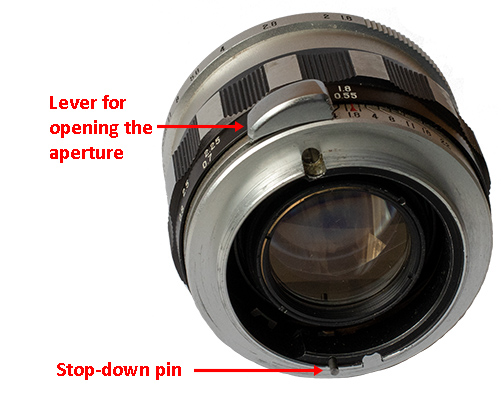 Auto-Takumar lens with semi-automatic diaphragm
Auto-Takumar lens with semi-automatic diaphragm
Fully-Automatic Diaphragm
The next innovation was development of a fully-automatic aperture mechanism capable of stopping down for exposure and reopening without user intervention. This improvement along with the earlier innovation of an instant return mirror allowed the photographer to easily address rapidly changing events and active subjects without removing their eye from the viewfinder. Fully-automatic aperture first made its appearance with Pentax in 1960 on some Auto Takumar lenses, but it was the Super-Takumar series that fully exploited this feature. As support for this feature was taken up by other makers of M42 cameras and lenses, it became commonplace to include "Auto" in the name for lenses having this feature, hence names like Auto-Rikenon, Auto-Yashinon, Auto Mamiya/Sekor, and so on. To allow backward compatibility with older-model bodies, most auto-aperture M42 lenses include a small switch or slider to allow either automatic or manual aperture operation. A happy side-effect of the Auto/Manual switch is that it effectively allowed operation equivalent to using a preset lens which comes in handy today when using these lenses on a digital SLR.
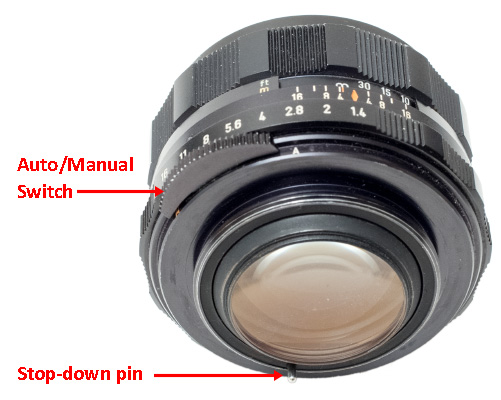 Super-Takumar with M42 mount with fully automatic aperture
Super-Takumar with M42 mount with fully automatic aperture
TTL Metering
While not an M42 mount feature per se, adding the aperture actuator to the camera allowed auto-aperture lenses to provide seamless support for stop-down TTL metering as originally featured in the Pentax Spotmatic and numerous other competing brands through the 1960s. Turning on the Spotmatic's meter triggered the stop-down mechanism for metering. This allowed for further streamlining of the process of taking pictures:
- Focus and frame the scene
- Turn on meter (this stops the lens down) and set aperture and shutter speed
- Shoot (this turns off meter and opens up the aperture)
- Focus, frame, and shoot again
- Repeat #4 as needed until either light or subject changes.
If haste is required, the above might be streamlined to an abbreviated form on the Spotmatic:
- Meter frame while focusing/framing, stopped-down
- Shoot (diaphragm will reopen with meter automatically switched off immediately afterward)
- Focus, frame, shoot again
- Repeat #3 as needed until a need to re-meter
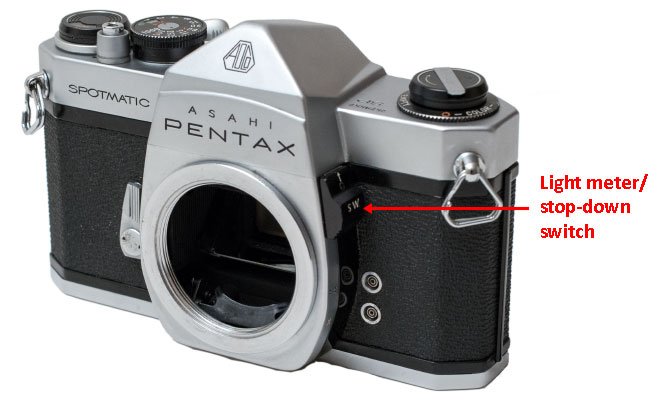 Spotmatic light meter/stop-down switch
Spotmatic light meter/stop-down switch
Open-Aperture Metering | Pentax M42 F/ES-mount
The early 1970s brought major changes to allow TTL metering with the lens aperture fully open. While Asahi Pentax was not alone in offering this feature with a variation of the M42 mount, its implementation is notable in that both supporting cameras and lenses were backward compatible to previous offerings from Pentax and other makers. Requirements for the implementation consisted of two main goals:
- Provision for constraining user-initiated lens stop-down with supporting lenses while retaining seamless support for legacy stop-down TTL metering with other lenses
- Coupling to communicate the aperture ring position relative to its full-open position
Changes to accomplish those goals included (the numbers in (..) refer to the illustrations below):
- Carving out a narrow ledge (1) at the inner margin of the body mount flange to accommodate a small interlock pin (2) on supporting lenses
- Providing couplings in the mirror box to engage matching pieces on the lens to detect lens orientation (3) and relative aperture ring position (4)
- Adding a lens position boss (5) and aperture ring "follower" tab (6) to the lens rear
- Adding a small pin (2) as part of an interlock to prevent use of the auto/manual switch on supporting lenses
Variations and Compatibility
While the vast majority of M42 cameras and lenses are cross-compatible with each other with few concerns, physical considerations and proprietary features on some lens series may create compatibility concerns for use with some cameras and/or adapters. Concerns fall into a few broad categories:
- Physical interference with mirror, aperture actuator, or other host body parts
- Light leaks from narrow lens flange when using an M42 mount adapter
- Poor engagement with adapter
If you have encountered compatibility issues please contact a PentaxForums administrator so that we can augment the table of known issues:
| Auto-Takumar 55mm F1.8 | Do not use lenses with a serial number smaller than 462500 with the SV and S1a since its automatic diaphragm will not work correctly (source: H3v/H1a operating manual) |
| Super-Takumar 50mm F1.4 lens (8-element version) |
This note refers to the early 8-element version of the Super-Takumar 50/1.4 (LINK) only. The protruding rear element on this lens may not clear the mirrors on pre-Spotmatic Pentax bodies. These include:
Later production SV, S1a, and Super S2 are free of this issue and may be identified as having an orange-red "R" on the film rewind crank knob rather than the green "R" found on earlier production. This is true for those models only. If unsure whether a particular Super-Takumar 50/1.4 lens is the 8-element version, the safe path is to not mount to any SV, S1a, and Super S2 body with a green "R" or any S1, S2, or S3 body regardless of "R" color. (Strangely, while all Spotmatic models are compatible, all have a green "R".) |
| Carl Zeiss Jena (CZJ) Biotar 58mm f/2 (preset aperture) |
Some versions of this lens have a protective collar on the rear element with potential to foul the mirror and/or mirror box hardware on some M42 cameras. That potential may also exist when adapted to non-M42 cameras. |
Techniques on Pentax Digital
First and foremost a M42 to K-mount adapter must be fitted to the digital camera body. The adapter must sit flush with the camera body. Certain third parties offer adapters with a flange - these are not recommended since they prevent focusing far out and at infinity. The adapter offered by Pentax is the best:
 Genuine Pentax M42 to K-mount Adapter
Genuine Pentax M42 to K-mount Adapter
Installing the adapter in the mount can be fiddly. The easiest way to do it is to first screw the adapter onto a lens, then mount the lens (with adapter), and finally screw the lens out leaving the adapter in place on the camera. You now effectively have a digital SLR with an M42 mount!
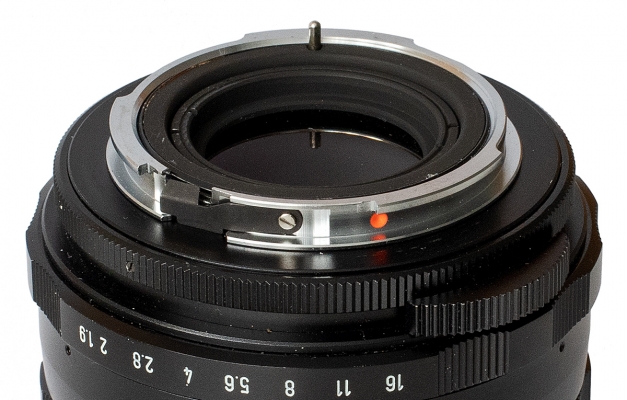 The genuine Pentax adapter mounted on lens
The genuine Pentax adapter mounted on lens
 The genuine Pentax adapter fits slightly loose and inset within the bayonet mount
The genuine Pentax adapter fits slightly loose and inset within the bayonet mount
There is no aperture linkage between the camera and lens, so the lens must be stopped down manually to the working aperture for metering and before shooting. This can conveniently be done with the A/M switch if present.
Shooting with M42 lenses on a Pentax DSLR goes like this:
- Dial in the focal length when prompted. This ensures that the shake reduction works correctly (if the camera doesn't prompt you for some reason, insert the value in the Recording Mode menu)
- Set the camera to Av exposure mode. Optionally set Auto ISO
- Open the lens aperture up fully, focus and frame
- Stop the lens down to the desired F-stop. Half-press the shutter button, the camera then adjusts shutter speed accordingly. Unless you use Auto ISO, adjust the ISO to the desired value (the camera will readjust the shutter speed to match the new ISO value)
- Shoot
- Repeat from step 3
You may have to set some exposure compensation to achieve proper exposure. The compensation value required may vary by lens and F-stop.
This method works in live view as well as in viewfinder view.
In a Nutshell
There are three variants of the M42 lens mount when talking Pentax and four types of aperture mechanism:
| M42 Lens Mount | Aperture Mechanism | Pentax Lens Name * | ||||
| Original |
|
|
||||
| With Stop-down Pin |
|
|
||||
| With Open-aperture Metering | - Automatic aperture | Super-Multi-Coated Takumar, SMC Takumar |
* There are some exceptions from this naming convention
The corresponding three camera mounts and the camera names are:
| M42 Camera Mount | Camera Models |
| Original | AP# (Tower 26), S (Tower 26), cameras fitted with the M42 to K-mount adapter |
| With flipper | K (Tower 29), S2 (H2), S3 (H3), S1 (H1), Super S2, SV (H3v), S1a (H1a), Spotmatic, SL, Spotmatic II, Spotmatic IIa, SP500, SP1000 |
| With flipper and open aperture metering | Spotmatic F, Electro Spotmatic, ES, ESII |
# The first Asahi Pentax model had no engraved model name. It is colloquially called "AP"
Any M42 lens can be used with any M42 camera. The features supported will be the least of what the lens and camera provide. There are a (very) few exceptions, though: refer the section "Variations and Compatibility" above.
The M42 section of PentaxForums lens database includes information on the mount type and aperture mechanism of all Pentax screw mount lenses. Likewise, the M42 section of the camera database provides the mount information for all Pentax screw mount cameras.
More from the Pentax Forums Homepage
- March "Flowers up Close" Contest...
- HD FA 50mm F1.4 vs. SMC 50mm F1.4 Classic Review
- Announcing Our April, 2024 Photo Contest
- Introducing Pentaxify AI by PentaxForums.com
- The Making of "Autumn Draws"
- Ricoh launches the RICOH GR III HDF and RICOH...
- Join Ricoh for the April 6 GR Photo Walk in Las...
- The Making of "Gotcha!"
Tags
dslr, lens, lens mount, m42, m42 mount, pentax mount, screw mount, slr

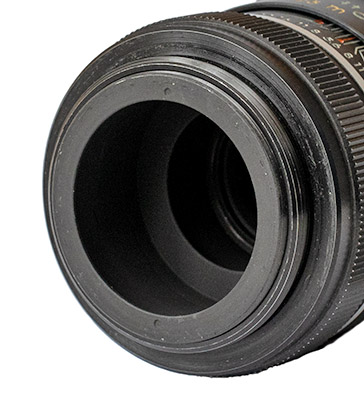
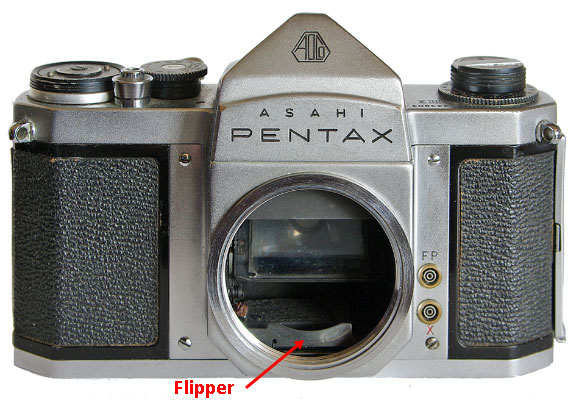

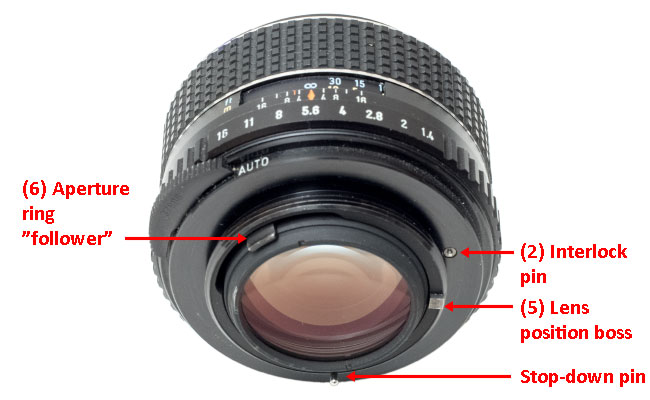


Comments